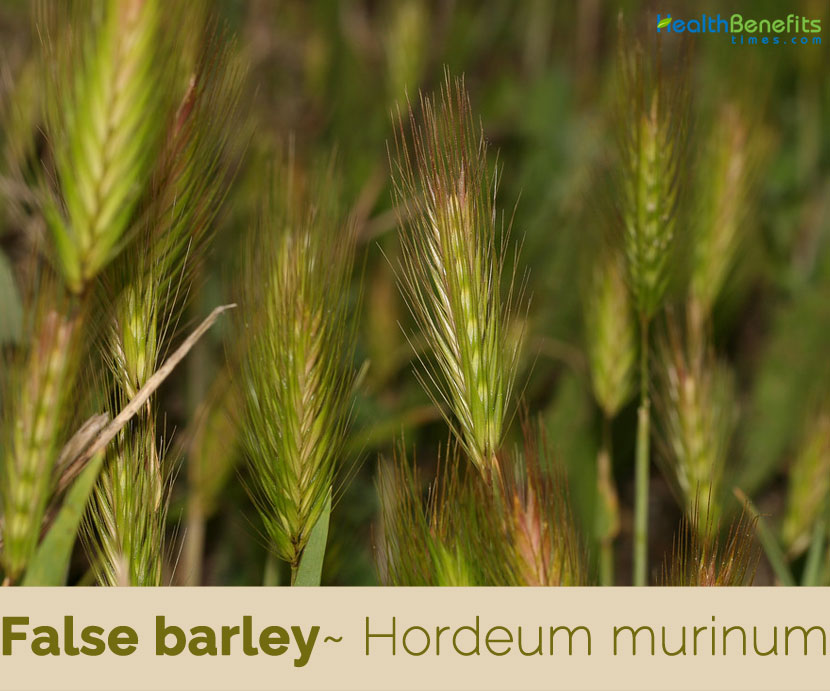| False Barley Quick Facts | |
|---|---|
| Name: | False Barley |
| Scientific Name: | Hordeum murinum |
| Origin | Central Europe, North Africa, western Asia, and the Caucasus region |
| Colors | Brown |
| Shapes | Dry fruit - caryopsis |
| Name | False barley |
|---|---|
| Scientific Name | Hordeum murinum |
| Native | Central Europe, North Africa, western Asia, and the Caucasus region. It has naturalized in North America, South America, Australia, and New Zealand |
| Common Names | False barley, Mouse barley, Wall barley, Wild barley, Farmer’s foxtail, bulbous barley, way barley, Smooth barley, Hare barley, way bentgrass, foxtail |
| Name in Other Languages | Albanian: Elb, elbi i egër Arabic: Sunbulet el fâr Brazil: Erva-de-espiga Bulgarian: Mishi echemik (миши ечемик) Catalan: Margall bord, espigadella, espigatrencat, pèl de ca, cua de rata Croatian: Stoklasa Czech: Je, ječmen myší Danish: Gold byg Dutch: Kruipertje, muizengerst English: False barley, Mouse barley, Wall barley, Wild barley, Farmer’s foxtail, bulbous barley, way barley, Smooth barley, Hare barley, way bentgrass Finnish: Hiirenohra French: Orge des murs, Orge des rats, Orge queue de souris, Orge queue-de-rat, Orge des souris, Way barley German: Hundsgerste, Mäusegerste Greek: Krithí i mýouros (Κριθή η μύουρος), agriokrítharo (αγριοκρίθαρο) Hungarian: Egérárpa Italian: Erba codola, Forasacco, Grano canino, Orzo dei muri, Orzo des ratti, Orzo selvatico, erba spiga, Orzo murino Japanese: Mugi kusa (ムギクサ) ko mugi (コムギ), mugi (ムギ), rai-mugi (ライムギ), ô-mugi (オオムギ) Netherlands: Gerst, muizen, kruipertje Norwegian: Musebygg Persian: جو وحشي Polish: Jęczmień płonny, jęczmień płony Portuguese: Cevada-de-ponche-verde, Cevada-dos-ratos, erva-de-espiga, Cevadinha-das-Lebres Romanian: Orzul șoarecilor Russian: Yachmen’ myshinnyy (Ячмень мышинный) Iachmen’ myshinnyi, yachmen’ zayachiy (ячмень заячий) Serbian: Divlji ječam (дивљи јечам), popino prase (попино прасе) Slovak: Jačmeň myší Slovene: Mišji ječmen Spanish: Cebadilla del campo, cebada ratonera, cebadilla, cola de zorro, espigadilla, cebada de ratones, cebadilla Silvestre, cola de ratim, pillanovias, pixaca, pizcanovias, spiguilla, Cebadilla ratonera Swedish: Vildkorn, Hiirenohra, harkorn Turkish: Duvar arpası, pisipisi out Ukrainian: yachminʹ myshachiy (ячмінь мишачій) |
| Plant Growth Habit | Many branched, spreading, or nearly prostrate annual grass |
| Growing Climates | Deserts, desert scrub, arid grassland, pastures, abandoned fields, open vegetation along roadsides, on the margins of cultivated fields, around buildings, irrigation ditches, vacant lots and lawns |
| Plant Size | Grow to 30 cm in height and its unbranched spikes can reach 10 cm long |
| Leaf | Leaf Sheaths are open and glabrous; auricles are well-developed on most leaves and can be 1-2 mm. long. Leaf blades are smooth to hairy and 2 to 6 mm wide |
| Flowering season | May through July |
| Flower | Racemes are single, linear, or oblong, bilateral and 4-12 cm long. Rhachis is delicate at the nodes and is flattened. Spikelet packing is broadside to rhachis |
| Fruit Shape & Size | Dry fruit – caryopsis |
| Fruit Color | Brown |
| Propagation | By Seed |
| Traditional Medicinal Use |
|
| Precautions |
|
Plant description
False barley is a many branched, spreading, or nearly prostrate annual grass that normally grows about 30 cm in height and its unbranched spikes can reach 10 cm long. The plant is found growing in Deserts, desert scrub, arid grassland, pastures, and abandoned fields, open vegetation along roadsides, on the margins of cultivated fields, around buildings, irrigation ditches, vacant lots and lawns. It is quite widespread and common. Leaf Sheaths are open and glabrous; auricles are well-developed on most leaves and can be 1-2 mm. long. Leaf blades are smooth to hairy and 2 to 6 mm wide. Ligules are barely 1 mm.
Inflorescence
Inflorescence is composed of racemes. Racemes are single, linear, or oblong, bilateral and 4-12 cm long. Rhachis is delicate at the nodes and is flattened. Spikelet packing is broadside to rhachis. Rhachis internodes are oblong and 3-3.5 mm long; falling with spikelet above. Fertile spikelets are sessile and 1 in the cluster. Companion sterile spikelets are pedicelled; 2 in the cluster. Pedicels are oblong.
Spikelets
Companion sterile spikelets are well-developed containing empty lemmas, or male; lanceolate, dorsally compressed, 7-11 mm long; as long as fertile; deciduous with the fertile. Companion sterile spikelet glumes are subulate, 16-30 mm long, eciliate on margins, or ciliate on margins. Companion sterile spikelet lemmas are exerted from glumes, 7-11 mm long with 10-40 mm long awn. Spikelets comprise of 1 fertile florets without rhachilla extension. Spikelets are lanceolate, dorsally compressed, 7-12 mm long and deciduous with accessory branch structures.
Glume
Glumes are collateral, similar; gaping. Lower glume is subulate about 25-30 mm long, 1 length of upper glume. Lower glume margins ciliate.
Florets
Fertile lemma is lanceolate, 7-12 mm long, coriaceous, without keel and 5 -veined. Lemma surface is scabrous; rough above. Lemma apex is acuminate and awned. Principal lemma awn is 18-50 mm long overall and limb scabrous.
Fruits
Caryopsis is with adherent pericarp, ellipsoid, sulcate on hilar side and hairy at apex. Embryo is 0.2 length of caryopsis. Hilum is linear.
Culinary uses
- Seed can be cooked and used as a piñole.
- The seed can be ground into a flour and used as a cereal in making bread, porridge etc.
Other Facts
- Weedy barley species is an important component of annual pastures.
- This is useful for feeding grazing animals.
- It is also the main source of forage for cattle production in areas with water deficits.
Management
In pasture, the grass should be cut or kept closely grazed down to prevent seeding and reduce injury to stock from the seed awns. Once the weed has flowered and set seed, even goats will not eat the seed heads. Maintaining a short but not overgrazed lawn has eliminated wall barley within 2 years. False barley does not compete well against a mixture of perennial ryegrass and white clover in the lawn.
References:
https://www.itis.gov/servlet/SingleRpt/SingleRpt?search_topic=TSN&search_value=40881#null
http://www.hear.org/pier/species/hordeum_murinum.htm
https://npgsweb.ars-grin.gov/gringlobal/taxonomydetail.aspx?id=19314
https://pfaf.org/user/Plant.aspx?LatinName=Hordeum+murinum
https://plants.usda.gov/core/profile?symbol=HOMU
https://en.wikipedia.org/wiki/Hordeum_murinum
https://www.cal-ipc.org/plants/profile/horderum-murinum-profile/
http://biology.burke.washington.edu/herbarium/imagecollection/taxon.php?Taxon=Hordeum%20murinum
http://www.tn-grin.nat.tn/gringlobal/taxonomydetail.aspx?id=102928
https://accs.uaa.alaska.edu/wp-content/uploads/Hordeum_murinum_ssp_leporinum_BIO_HOMUL.pdf
http://www.theplantlist.org/tpl1.1/record/kew-419414
https://gd.eppo.int/taxon/HORMU
https://www.flowersofindia.net/catalog/slides/Hare%20Barley.html
https://www.cabi.org/isc/datasheet/27659
https://www.wikidata.org/wiki/Q161674
http://www.plantsoftheworldonline.org/taxon/urn:lsid:ipni.org:names:405301-1
Comments
comments
